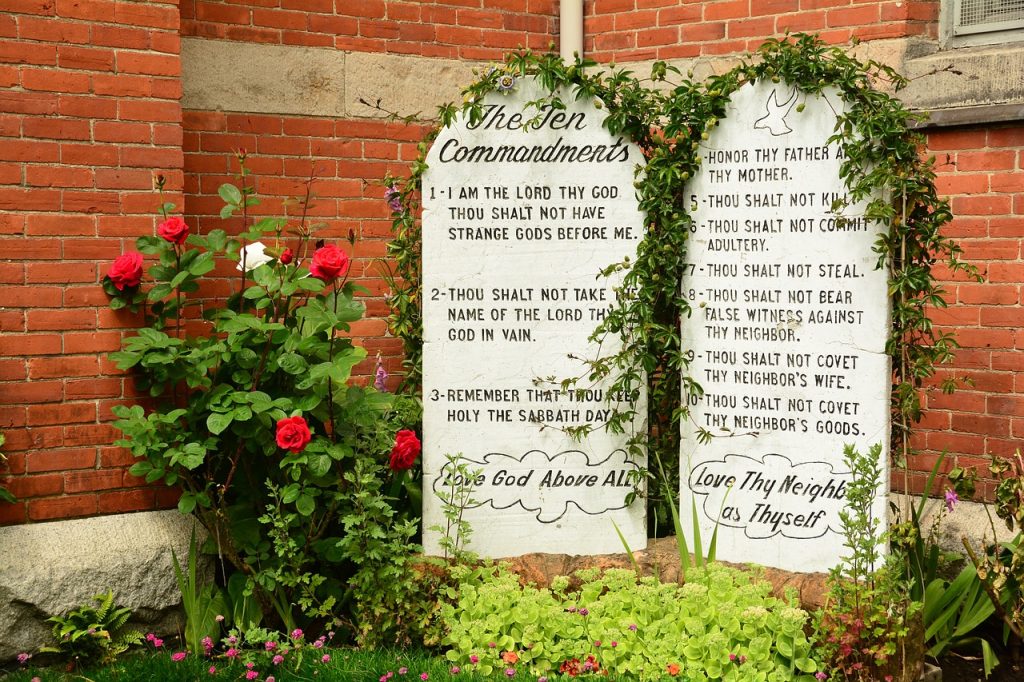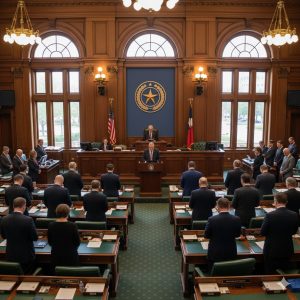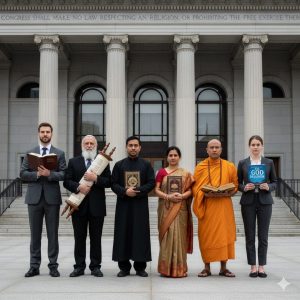
A Texas Senate committee recently advanced two controversial bills that would require public school classrooms to display the Ten Commandments and allow time for student prayer during school hours (Ten Commandments bill advanced by Texas Senate panel | The Texas Tribune). Supporters hail these measures as a return to moral foundations, but many educators, legal experts, and faith leaders are raising alarms about the implications for the First Amendment and the historical American principle of separating church and state. This latest push in Texas is unfolding against the backdrop of shifting legal precedents and has reignited debate over how to uphold religious freedom for all faiths in public life.
Historical and Constitutional Context
The United States was founded on a commitment to religious liberty and pluralism. The First Amendment of the U.S. Constitution pointedly forbids government establishment of religion while protecting the free exercise of faith: “Congress shall make no law respecting an establishment of religion, or prohibiting the free exercise thereof.” Early American leaders understood that true religious freedom required government neutrality in matters of worship. In an 1802 letter, President Thomas Jefferson famously described the First Amendment as building “a wall of separation between Church and State.” Decades later, the U.S. Supreme Court affirmed this concept. “The First Amendment has erected a wall between church and state. That wall must be kept high and impregnable,” wrote Justice Hugo Black in Everson v. Board of Education (1947) (Everson v. Board of Education of Ewing Township | Constitution Center), underscoring that even the slightest breach of church-state separation was unacceptable.
This principle was not anti-religious; rather, it was born from the Founders’ understanding of history. Many early Americans (including Baptists, Quakers, and other minority denominations) had fled or opposed regimes where state-imposed religion led to persecution. James Madison, the “Father of the Constitution,” noted with satisfaction in 1819 that separating church and state had actually strengthened both government and religion. “The experience of Virginia conspicuously corroborates the disproof” of the old assumption that religion needed state support, Madison wrote, observing that “the number, the industry, and the morality of the Priesthood, and the devotion of the people, have manifestly increased by the total separation of church from the state” (Religious Liberty: The Commandments of God, the Faith of Jesus – Southern Tidings). In other words, faith can flourish on its own in a free society – indeed, it flourishes best when individuals are persuaded in heart and mind, not coerced by law.
Legal Precedents on Religion in Public Schools
For over half a century, U.S. courts have applied the First Amendment to strike a careful balance in public education. The Supreme Court has consistently held that while students may pray individually and religion can be discussed objectively, public schools (as government entities) cannot sponsor or endorse religious exercises. In the landmark 1962 case Engel v. Vitale, the Court ruled that officials may not lead prayers in public schools – even if participation is voluntary and the prayer is non-denominational (Texas lawmakers push for Ten Commandments, prayer in schools | The Texas Tribune). The following year, in Abington School District v. Schempp, the Court likewise prohibited school-sponsored Bible readings. And in 1980, the Court struck down a Kentucky law requiring the posting of the Ten Commandments in each public classroom, finding no secular legislative purpose for such a mandate (Texas lawmakers push for Ten Commandments, prayer in schools | The Texas Tribune). At the time, the justices applied the longstanding “Lemon test” (from 1971’s Lemon v. Kurtzman) which required laws to have a primarily secular purpose and avoid entangling government with religion (Texas lawmakers push for Ten Commandments, prayer in schools | The Texas Tribune). Posting a plainly sacred text like the Ten Commandments failed that test as an impermissible government endorsement of religion.
These rulings – Engel, Schempp, Stone v. Graham, and others – cemented the understanding that public schools must remain neutral in matters of faith. Students of course are free to pray individually or in groups, as long as it’s not disruptive, and schools can teach about religion in history or literature classes. But the schools themselves cannot initiate or require religious observances. This careful stance protects students’ freedom of conscience: children cannot be pressured by school authorities to participate in religious worship against their or their family’s beliefs. As the Supreme Court noted, the government may not coerce any student to proclaim or renounce any faith.
Recent shifts in the judiciary, however, have emboldened those seeking to blur the church-state line. In 2022, the Supreme Court’s decision in Kennedy v. Bremerton School District upheld a public high school coach’s right to pray at the 50-yard line after games, casting it as a personal devotional act protected by the First Amendment (NEW ISSUES INVOLVING RELIGIOUS LIBERTY AND THE TEN COMMANDMENTS — ADvindicate). In doing so, the Court’s conservative majority indicated a departure from the strict Lemon test that had guided church-state jurisprudence for decades (Texas lawmakers push for Ten Commandments, prayer in schools | The Texas Tribune). The Kennedy ruling favored a new analysis based on “historical practices and understandings” – essentially asking whether a practice of religious expression in public life is grounded in U.S. tradition (Texas lawmakers push for Ten Commandments, prayer in schools | The Texas Tribune). This history-based approach is admittedly vague and has left legal experts uncertain about its boundaries (Texas lawmakers push for Ten Commandments, prayer in schools | The Texas Tribune). Nevertheless, many Christian conservatives see it as an opening to revisit (and potentially overturn) previous bans on school-sponsored prayer and religious displays (Texas lawmakers push for Ten Commandments, prayer in schools | The Texas Tribune). The current Supreme Court, with a solid conservative supermajority, has given them reason to believe that some forms of religious expression in schools that were once deemed unconstitutional might now pass muster.
The Texas legislators pushing the Ten Commandments and prayer bills have explicitly cited these recent court developments as justification. “After the Kennedy decision, there is no merit in prohibiting expressions of faith or our collective history,” argued one Texas lawmaker in support of putting the Ten Commandments in classrooms (Texas lawmakers push for Ten Commandments, prayer in schools | The Texas Tribune). Attorneys from First Liberty Institute – a legal group that represented Coach Kennedy – testified that the case was a “huge paradigm shift” and claimed that a Ten Commandments display would now be considered constitutional because of the commandments’ historical influence on American law (Ten Commandments bill advanced by Texas Senate panel | The Texas Tribune). To opponents, these claims dangerously misread both history and the law. (Notably, a federal judge in Louisiana just last year struck down a nearly identical law requiring Ten Commandments in classrooms as “unconstitutional on its face,” though that case is now on appeal (Texas lawmakers push for Ten Commandments, prayer in schools | The Texas Tribune).) But buoyed by the new judicial climate, Texas and at least 15 other states have seen proposals to introduce organized prayer or mandated religious displays in public schools (Ten Commandments bill advanced by Texas Senate panel | The Texas Tribune). The battle lines are drawn between those who view such measures as a rightful acknowledgment of America’s religious heritage and those who see them as a direct assault on the Constitution’s Establishment Clause.
The Seventh-day Adventist Perspective on Religious Liberty
Among the strongest champions of strict church-state separation are faith communities who understand the dangers of government favoritism in religion. Seventh-day Adventists, for example, have a unique perspective rooted in their own history as a minority Protestant denomination. From its inception in the mid-19th century, the Adventist Church “emphasized the importance of religious liberty, advocating for the right to believe – or not believe – according to one’s conscience, free from government interference.” (The Seventh-day Adventist Church’s Legacy in Advocating for Religious Freedom – ReligiousLiberty.TV / Founders’ First Freedom® – News and Updates on Religious Liberty and Freedom) This commitment was not merely theoretical. Adventists faced their own tests of liberty when Sunday rest laws (mandating Sunday as a day of worship) swept through parts of the country in the late 1800s, threatening to penalize those who, like Adventists, observed a different Sabbath day (The Seventh-day Adventist Church’s Legacy in Advocating for Religious Freedom – ReligiousLiberty.TV / Founders’ First Freedom® – News and Updates on Religious Liberty and Freedom). In response, Adventists became vigorous religious freedom advocates, defending not just their rights but the principle of liberty of conscience for all. In 1893, Adventist leaders helped establish the International Religious Liberty Association, and in 1906 the church launched Liberty magazine – a publication dedicated to protecting freedom of belief and maintaining a clear boundary between church and state (The Seventh-day Adventist Church’s Legacy in Advocating for Religious Freedom – ReligiousLiberty.TV / Founders’ First Freedom® – News and Updates on Religious Liberty and Freedom) (The Seventh-day Adventist Church’s Legacy in Advocating for Religious Freedom – ReligiousLiberty.TV / Founders’ First Freedom® – News and Updates on Religious Liberty and Freedom). For over a century, Liberty magazine and Adventist public affairs ministries have consistently championed the idea that the government should neither suppress nor promote religion, but remain neutral so that faith can flourish by persuasion, not coercion (The Seventh-day Adventist Church’s Legacy in Advocating for Religious Freedom – ReligiousLiberty.TV / Founders’ First Freedom® – News and Updates on Religious Liberty and Freedom).
It may seem ironic that a devout Christian group known for upholding the Ten Commandments (Adventists even keep the seventh-day Sabbath of the Decalogue) would oppose displaying the Ten Commandments in public schools. But Adventists distinguish between personal faith and state compulsion. As one Adventist religious liberty director explains, “While Seventh-day Adventists hold the Ten Commandments up as the law of God, we do not strive to enforce religious dogma upon the state or the citizens in the state.” (Religious Liberty: The Commandments of God, the Faith of Jesus – Southern Tidings) In the Adventist view, the moment the government steps in to mandate a religious observance or text, that religious expression ceases to be fully genuine – it becomes a form of legal compliance rather than an act of sincere belief. Adventists worry that when the state favors one faith, it inevitably marginalizes others (a concern they keenly feel, being a minority themselves). They note that both the U.S. and Texas constitutions were designed to prevent any “single religion from rising to the top.” Giving governmental preference to Judeo-Christian teachings, however well-intended, “is dangerous to minority religions, and thus an impediment to true religious freedom for all.” (Religious Liberty: The Commandments of God, the Faith of Jesus – Southern Tidings) In short, religious liberty advocates like the Adventists believe the government has no business playing favorites among faiths – not only for the sake of religious minorities, but for the integrity of religion itself.
This perspective is shared by many other faith leaders. During the Texas Senate hearing on the bills, representatives from Baptist and interfaith organizations echoed the warning that entangling church and state ultimately harms both. “All Baptists are called to protect the separation of church and state,” testified Jody Harrison of Baptist Women in Ministry, invoking the proud history of Baptist opposition to state-established religion. “Is it really justice to promote one type of Christianity over all schoolchildren?” (Ten Commandments bill advanced by Texas Senate panel | The Texas Tribune) she asked pointedly. Even some Christian supporters of the legislation conceded that their goal was explicitly evangelistic – one senator asserted that children needed to be exposed to Christianity to save their souls (Ten Commandments bill advanced by Texas Senate panel | The Texas Tribune). Such frank admissions only heightened the concerns of opponents that these laws amount to the government taking on a religious teaching role.
Why Government-Sponsored Religion Harms Everyone’s Freedom
Advocates of church-state separation insist that religious freedom must be a universal principle – protecting all faiths and also the freedom to refrain from religion. When government officials endorse a specific religious message (like posting the Ten Commandments or leading prayers), it may appear to benefit the majority religion at first. But history and experience show that in the long run, government entanglement with religion is harmful even to those it aims to help. How so? Consider several key reasons:
- Undermining Voluntary Faith: Religious devotion should be voluntary, arising from personal conviction. The moment the state coerces religious expression, faith risks becoming hollow compliance. Students compelled to recite prayers or see sacred texts treated as official school decor may grow cynical or resistant. True belief cannot be legislated – it must be freely chosen. As one observer quipped, a government big enough to inject religion into public life is also big enough to dictate which religion and how it is practiced. Today it might be a generic Christian display; tomorrow it could be a version at odds with your own denomination’s beliefs.
- Exclusion of Minority Faiths: When a public school elevates one religious tradition, children from other faith backgrounds (or no faith) inevitably feel like second-class citizens. For example, non-Christian students in Texas could feel alienated or pressured if their classrooms prominently feature Christian commandments and school-sanctioned prayers (Ten Commandments bill advanced by Texas Senate panel | The Texas Tribune). This is not a hypothetical fear – it’s exactly what the First Amendment’s Establishment Clause was designed to prevent. Every student should feel equally welcome in a public school, regardless of their creed. Creating an atmosphere where one religion is officially preferred can lead to stigma and bullying of those who don’t conform, damaging the social fabric of the school community.
- Sectarian Divisions: Even within Christianity and Judaism, there are multiple versions of the Ten Commandments. Catholics, Protestants, Jews, and Eastern Orthodox number the commandments differently or emphasize different wording. Which version would Texas schools post? That’s an uncomfortable question lawmakers have not answered. As one U.S. congressman once noted in debate, “Which version of the Ten Commandments will be posted? The Catholic version? The Protestant version? They’re different, you know.” (NEW ISSUES INVOLVING RELIGIOUS LIBERTY AND THE TEN COMMANDMENTS — ADvindicate) By picking one, the state could inadvertently take sides in a sectarian disagreement, a prospect that should give even Christians pause. Government entanglement in religion often ends up privileging one denomination’s viewpoint over another’s – the very scenario America’s founders (many of whom remembered sectarian strife in Europe) sought to avoid.
- Diminishing the Sacred: Paradoxically, turning the Ten Commandments into a mandatory classroom display may trivialize their religious significance. The Decalogue in Scripture is meant to be a covenant between God and believers – a sacred guide to moral living. Plastering these holy words on a school wall as a civic lesson or discipline tool strips them of their devotional context. Some Christian opponents argue that forcing the commandments into a secular setting “diminishes a sacred text by stripping it of its religious nature.” (Ten Commandments bill advanced by Texas Senate panel | The Texas Tribune) It treats God’s law as just another historical document or moral checklist, which many believers feel is disrespectful to the true spirit of their faith. In short, state-sponsored piety can degrade the very religious message it seeks to promote.
- Faith Weakened by State Dependence: When churches turn to the government to do the work of religious instruction or moral education, it may signal a deeper weakness in those religious institutions. Reliance on state power to prop up religion can mask a decline in genuine spiritual influence. History provides numerous examples: as soon as Christianity became the official religion of the Roman Empire, it lost some of its earlier purity and zeal; in medieval Europe, state-supported churches often persecuted dissenters rather than persuading them. A prominent Seventh-day Adventist author observed that whenever the church loses the true spirit of Christ, “she has reached out for the strong arm of the state to enforce her dogmas” (Religious Liberty: The Commandments of God, the Faith of Jesus – Southern Tidings) – a move that invariably backfires. Forced righteousness breeds hypocrisy (people going through the motions) and public resentment, whereas authentic faith thrives on persuasion and love, not legal compulsion. Moreover, if a religion ties its fortunes to political power, what happens when political winds shift? The favored faith of today could become tomorrow’s oppressed minority when a different group ascends to power. Thus, it’s in the long-term interest of all religious groups to keep the state out of the religion business.
- Driving People Away from Religion: Finally, one of the most counterintuitive consequences of government pushing religion is that it can actually drive people away from faith. Modern sociological data in the United States shows a rise in religiously unaffiliated Americans (the “nones”), especially among younger generations. Many cite discomfort with the mixing of religion and partisan politics as a reason for distancing themselves from organized religion. Interfaith leaders in Texas have warned that aggressive efforts to declare America a “Christian nation” or to inject one faith into public institutions are backfiring, alienating people who might otherwise be open to spiritual ideas (Texas lawmakers push for Ten Commandments, prayer in schools | The Texas Tribune). In the long run, religion stands to lose credibility and followers if it is seen as just another political agenda. By contrast, when the church remains separate from the state, it can speak with moral independence and focus on service, attracting people by example rather than by law.
In light of these points, even many devout Americans believe that voluntary prayer and Bible study – at home, in houses of worship, or among students on their own time – is far preferable to anything mandated in a public classroom. The beauty of the First Amendment’s approach is that it protects both freedom of religion and freedom from religious coercion. It allows the faithful to practice their beliefs openly, and it shields the minority (or non-believer) from having the majority’s religion forced upon them. As the Baptist Joint Committee on Religious Freedom succinctly put it, the U.S. Constitution and laws are not based on any single faith tradition: “When you look at the U.S. Constitution, there is no mention of God. There is no mention of Christianity. The only mention of religion is to prohibit religious tests for public office.” (Texas lawmakers push for Ten Commandments, prayer in schools | The Texas Tribune) In a pluralistic nation, the government’s role is to guard a neutral public square where people of all faiths or none can coexist peaceably, each free to follow their own conscience. That neutrality is not anti-religious; it is the very condition that makes genuine faith possible in a diverse society.
Defending the Wall of Separation: A Call to Action
The Texas bills requiring Ten Commandments displays and sanctioning official prayer in schools are more than just local proposals; they are a bellwether for the nation’s commitment to the separation of church and state. Will we uphold the principle that has safeguarded American religious freedom for centuries, or allow it to be eroded under the pressure of contemporary culture wars? History teaches us that once the government crosses the line into endorsing a particular faith, the rights of everyone — majority and minority alike — are put at risk. As citizens who value both our religious heritage and our constitutional liberties, we should approach these issues with great care and wisdom.
Now is the time for thoughtful, informed engagement. We can respect the sincere desires of those who worry about moral decline in our schools, yet gently remind them (and our legislators) that true moral education starts in homes and hearts, not in government dictates. We can encourage voluntary expressions of faith without violating others’ rights. And we must hold our leaders accountable to the Constitution’s promise that all are equal under the law, regardless of religion.
Every voice counts in this ongoing conversation. You can make a difference by staying informed and speaking up. Support local and national efforts that defend religious liberty — whether by joining interfaith coalitions, writing to your representatives, or simply discussing these issues with your community. Importantly, consider supporting further research, journalism, and content creation on church-state separation and religious freedom. High-quality, nuanced analysis (like the article you’ve just read) is crucial for educating the public and policymakers about what’s at stake. By donating to organizations and publications dedicated to upholding the First Amendment’s guarantees, you help ensure this vital work continues. In a time when basic constitutional principles face new challenges, investing in vigilance and education is an act of patriotism and faith.
In conclusion, protecting the freedom of religion requires protecting freedom from government-imposed religion. Whether you are an Adventist, Baptist, Catholic, Jew, Muslim, humanist or anything else, this principle shields your right to worship according to your conscience. Let us reaffirm the wisdom of that old high wall of separation – not to push faith out of public life, but to keep it in its proper, sacred sphere. In doing so, we honor both God and the Constitution, ensuring that religion in America thrives by the power of persuasion and truth, never by the coercive hand of the state. Together, we can stand for a future where religious freedom remains a cornerstone of our democracy – but we must act, and support those on the front lines of this urgent cause, to keep the flame of liberty burning bright. (Religious Liberty: The Commandments of God, the Faith of Jesus – Southern Tidings) (Ten Commandments bill advanced by Texas Senate panel | The Texas Tribune)


